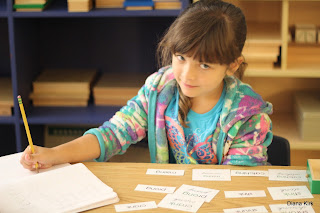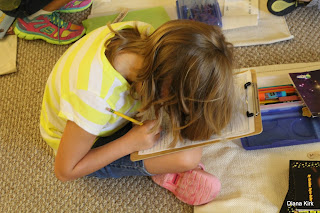Lower Elementary Montessori is different from Primary Montessori in many ways. This is the basic procedure for completing a lesson in our classroom.
First, a child chooses a lesson that has been presented to her. The teacher has observed the child and has shown her this lesson to meet the needs of the child. As in Primary, the child chooses a work space and brings the lesson and the rest of her materials to her work space. Once she is ready, she writes the lesson in her work plan. The work plan is a great tool for the child, teacher, and parent to see at a glance what they have been working on in class. Eventually it is used as a planning tool for the child.

After it is written on the work plan, she completes the lesson. This is the Compound Word Key Experience. A Key Experience is the first presentation of a lesson or how the teacher introduces a concept to a child. Although this child has had experience with compound words in her Primary class, this is the first time compound words have been introduced to her as a combination of root words. After the Key Experience, the child is shown several follow-up works until she reaches mastery.
After she completes the lesson, she records it. In this case, she will write the words and draw the objects. Recording lessons is required in Lower Elementary. About 90% of our lessons are recorded in some way.
After she is finished recording, she cleans up her work and returns it to the exact spot she finds it in. Then she moves on to something else she feels the need to practice.
































